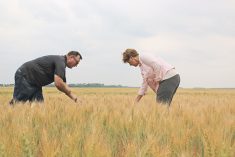Agriculture ministers and industry officials stress the importance of basing future decision-making process on science
A new federal-provincial-territorial working group will tackle the challenges of pesticide management, said Canadian agriculture minister Marie-Claude Bibeau after last week’s meeting with her counterparts.
Those who have criticized the government for decisions that go against its claim of relying on scientific evidence, such as the recently ended pause on maximum residue level increases, welcomed the news.
Saskatchewan agriculture minister David Marit said provinces can’t all be painted with the same brush and cited the Pest Management Regulatory Agency’s decision to ban the use of lambda-cyhalothrin on crops used for feed as an example of a flawed decision.
Read Also

Huge Black Sea flax crop to provide stiff competition
Russia and Kazakhstan harvested huge flax crops and will be providing stiff competition in China and the EU.
He said American farmers still use it and are likely shipping feed to Canada.
“The other thing is, we can still use it here for food,” he said. “The elevators don’t know if it’s for food or for feed because of grading.”
As well, byproducts from pulses and oats go into animal feed. He said the working group gives the sector and provinces “an avenue to go to PMRA and have a very good discussion.”
Canada Grain Council president Erin Gowriluk said the council sent a letter to all ministers ahead of the FPT meeting to commit to ongoing dialogue on this topic.
She said there has been concern about government messaging around some of its announcements. For example, the government recently said it would ban cosmetic pesticide use on federal land even as it lifted the pause on an MRL increase.
Some announcements have come right at an election call.
“We can point to a few examples where we’ve seen a level of what I would suggest is political interference in some of these, in what would otherwise be science-based decisions,” she said.
The council wanted the ministers to note the important role that pesticides can play in helping to achieve sustainability goals, she said, but also to ensure the process is science- and evidence-based.
Gowriluk said the council suggested the ministers create a forum and they did. There are still questions about who will be part of the group and how it will engage stakeholders. The council has asked for a meeting with Bibeau’s office to get more information.
She also noted that the sector leaders who participated in the Canadian Federation of Agriculture ministerial roundtable ahead of the FPT demonstrated the strides farmers are making without government regulation.
The roundtable focused on the Sustainability Agriculture Strategy that Ottawa is developing. Gowriluk said farmers and organizations are already doing the right things with public, meaningful commitments to sustainability measures.
“I think the government would be well served to follow their leadership, not the other way around, because we have some real leaders in this space,” she said, adding government support and funding are critical components.
CFA president Keith Currie said government has to get the message that environmental issues are much more than climate change.
“For us in the long game, it’s got to be broader than that,” he said.
CFA is pushing for a whole-of-government approach to sustainability and Currie said he heard provincial ministers echo that.
“As I pointed out to the provincial ministers, that means they have to go back to their respective governments and repeat that message, too,” he said.
“This has to be a collective partnership for any of this to work. This can’t be top down. If this is going to cost us money and make us go broke, guess what, we’re just not going to do it.”
Currie said he expects a strategy framework could be available later this year, but he also said the timing might depend on the election and budget cycles. Pre-budget submissions for next year are due in August.
Both meetings also addressed issues such as animal disease and labour.
Manitoba agriculture minister Derek Johnson said he got “up on my soapbox” and talked about how it makes sense to ensure that zones are developed in case African swine fever arrives in Canada.
He said zones should not be formed according to borders but rather by trading areas. For example, many Saskatchewan hogs move live to Manitoba for processing. A zone that stops at the provincial border would cause significant problems for the industry, he added.


















